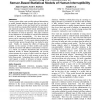Free Online Productivity Tools
i2Speak
i2Symbol
i2OCR
iTex2Img
iWeb2Print
iWeb2Shot
i2Type
iPdf2Split
iPdf2Merge
i2Bopomofo
i2Arabic
i2Style
i2Image
i2PDF
iLatex2Rtf
Sci2ools
CHI
2004
ACM
2004
ACM
Examining the robustness of sensor-based statistical models of human interruptibility
Current systems often create socially awkward interruptions or unduly demand attention because they have no way of knowing if a person is busy and should not be interrupted. Previous work has examined the feasibility of using sensors and statistical models to estimate human interruptibility in an office environment, but left open some questions about the robustness of such an approach. This paper examines several dimensions of robustness in sensor-based statistical models of human interruptibility. We show that real sensors can be constructed with sufficient accuracy to drive the predictive models. We also create statistical models for a much broader group of people than was studied in prior work. Finally, we examine the effects of training data quantity on the accuracy of these models and consider tradeoffs associated with different combinations of sensors. As a whole, our analyses demonstrate that sensor-based statistical models of human interruptibility can provide robust estimates...
CHI 2004 | Human Computer Interaction | Predictive Models | Sensor-based Interfaces | Sensor-based Statistical Models |
| Added | 01 Dec 2009 |
| Updated | 01 Dec 2009 |
| Type | Conference |
| Year | 2004 |
| Where | CHI |
| Authors | James Fogarty, Scott E. Hudson, Jennifer Lai |
Comments (0)

